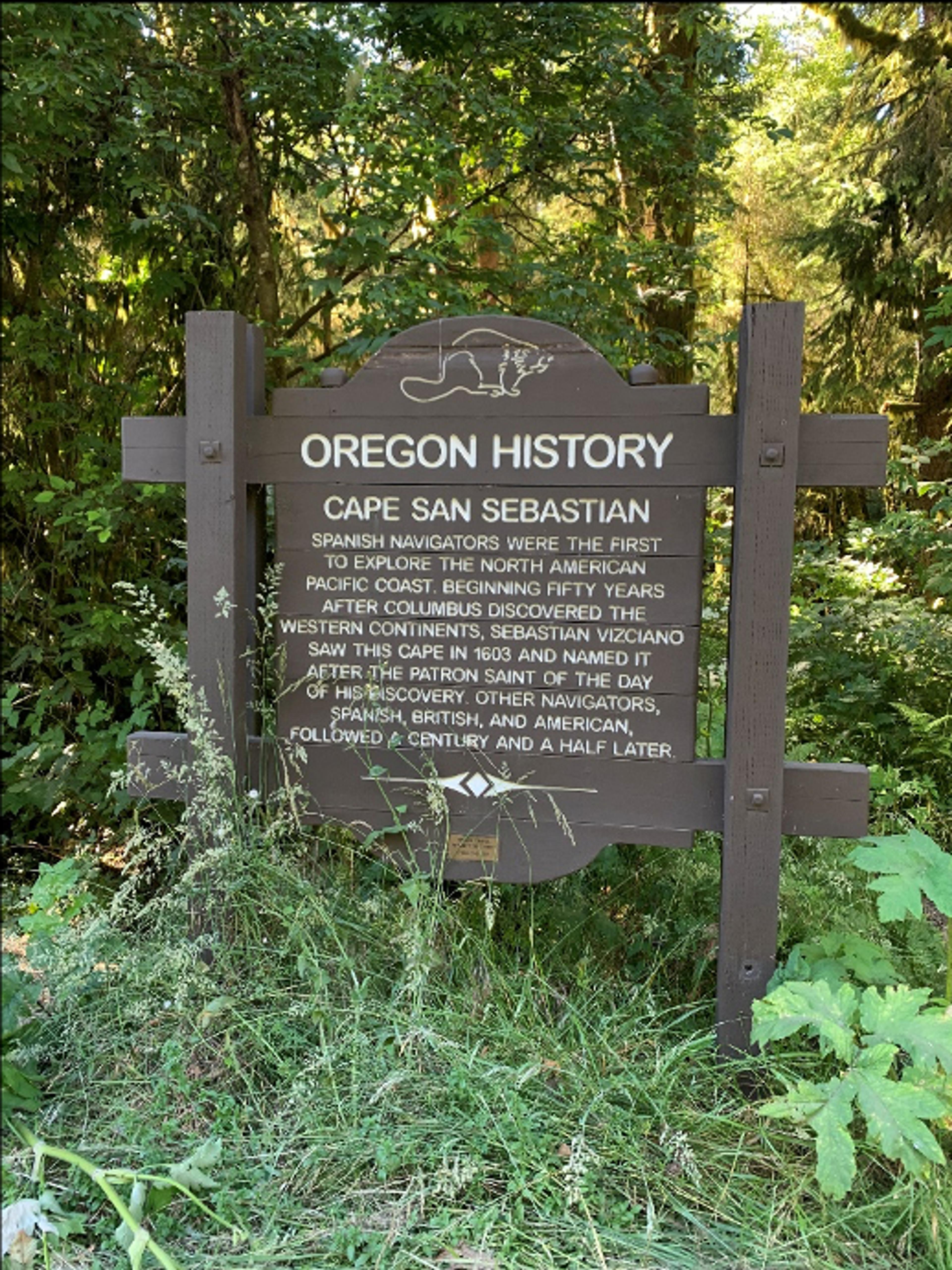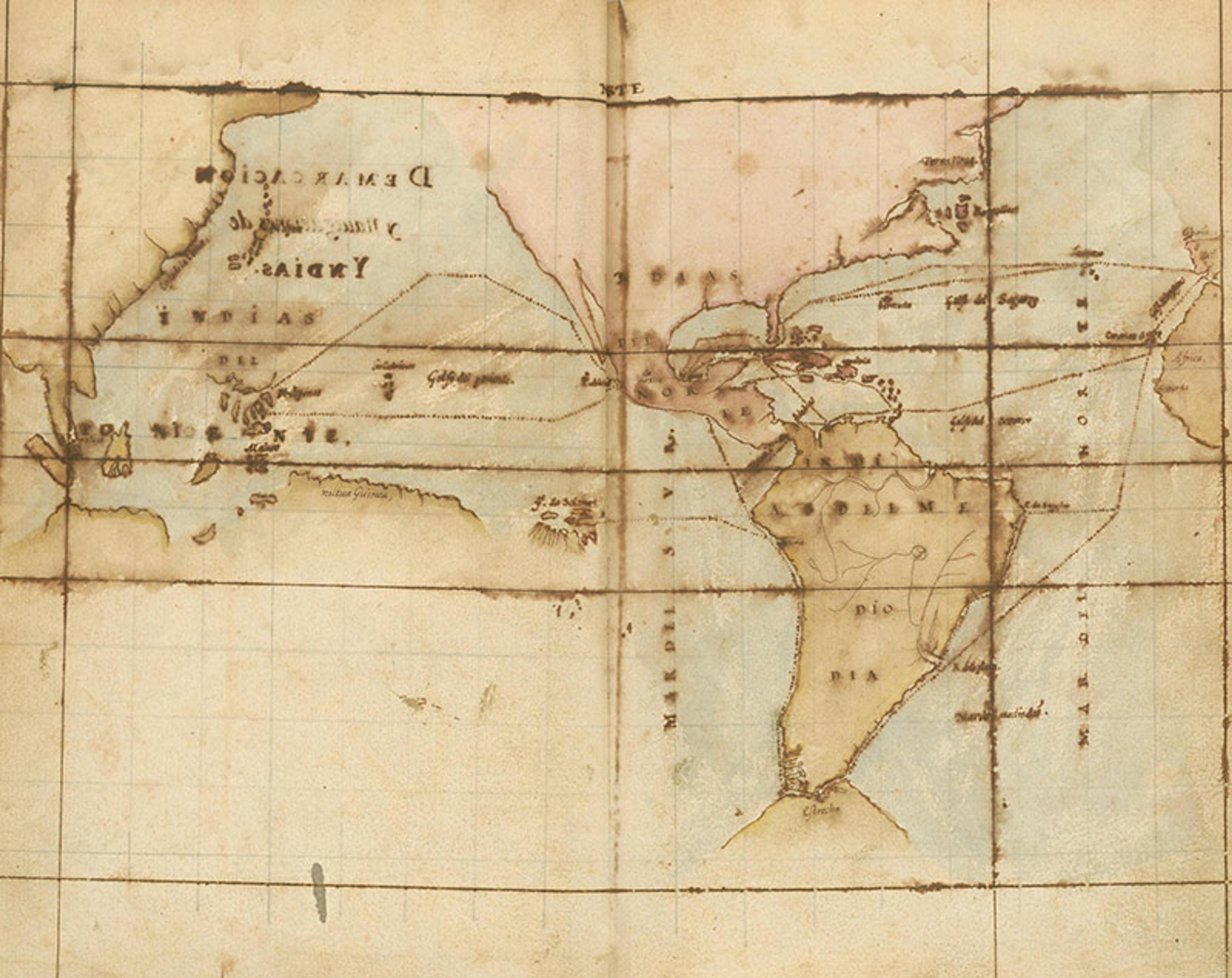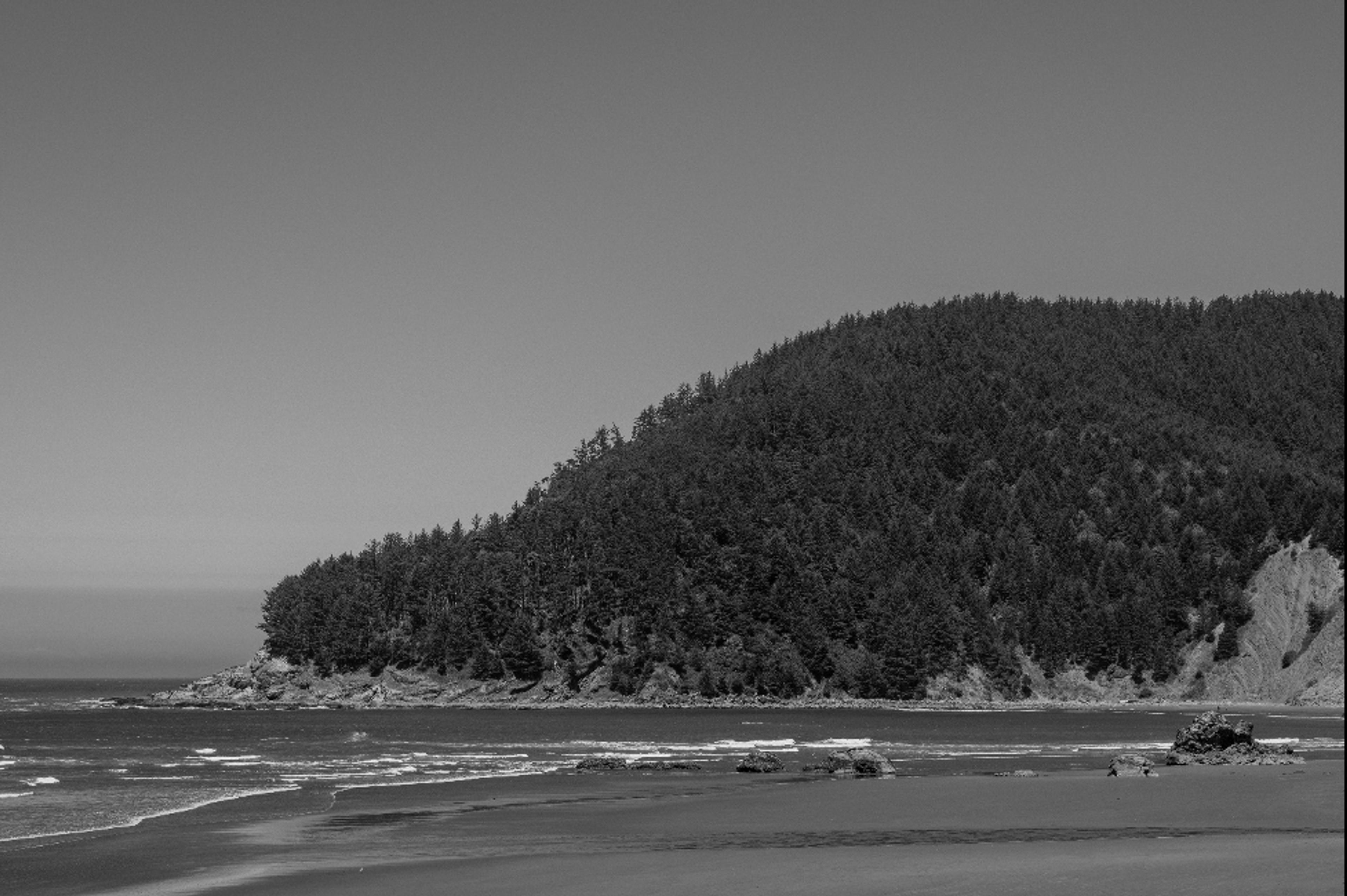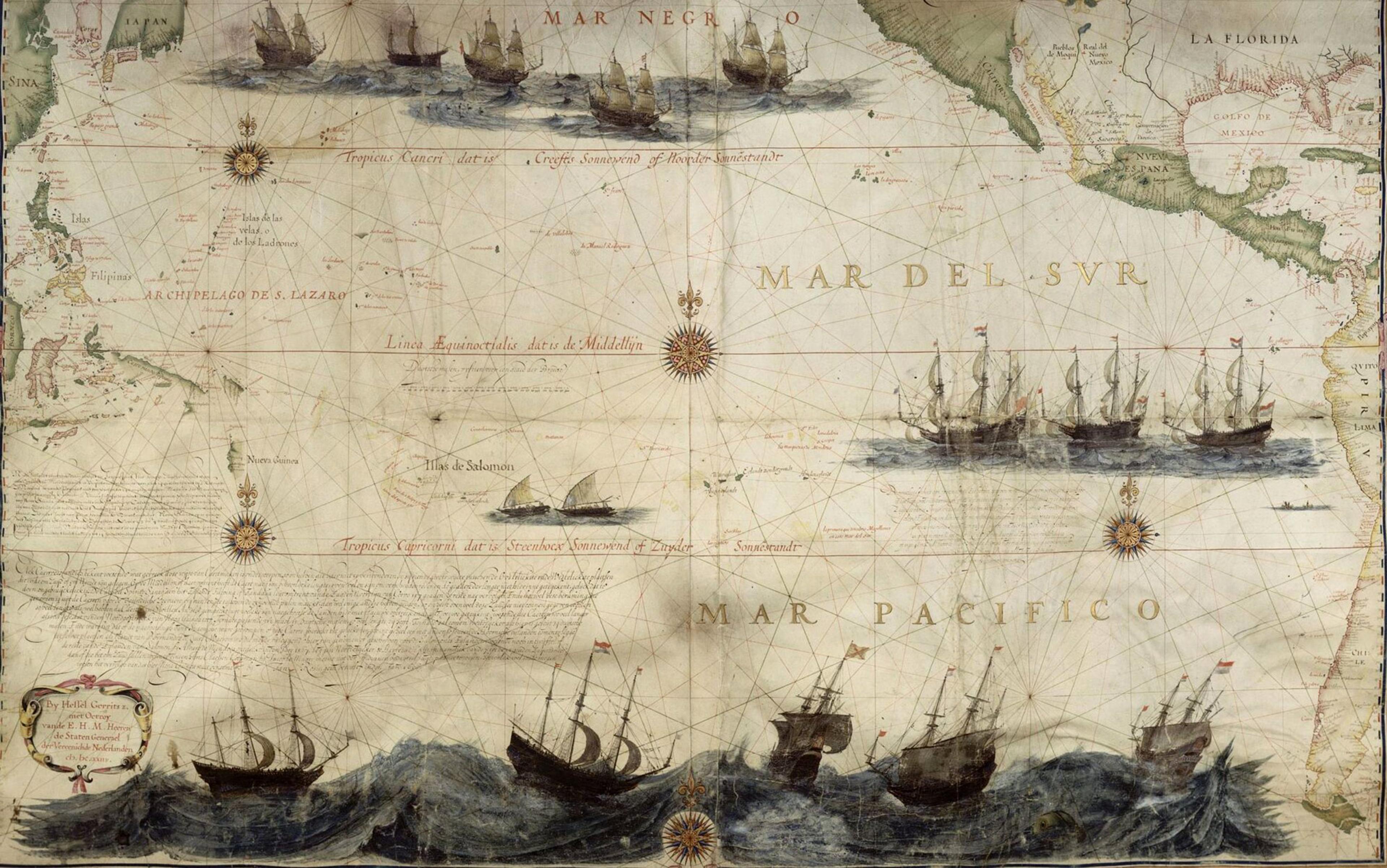Cape Sebastian in Oregon perches above two forested declivities along a rocky patch of the state’s southern coast. Travel there today, and you are likely to miss a roadside marker that reads:
Spanish navigators were the first to explore the North American Pacific Coast. Beginning fifty years after Columbus discovered the Western continents, Sebastian Vizciano [sic] saw this cape in 1603 and named it after the patron saint of the day of his discovery. Other navigators, Spanish, British, and American, followed a century and a half later.

The nearly overgrown historical marker at Cape Sebastian. Reproduction courtesy of the author
Standing before this sign, I winced rather predictably as I read ‘discovery’. But simmering beneath my displeasure with this word was a deeper conviction that Sebastián Vizcaíno’s voyage was, indeed, significant, though not in the ways that the sign suggests. Thousands of miles to the east, in Seville, the old centre of the Spanish Empire, I had stumbled upon Vizcaíno’s voyage in the dusty volumes of treasury records for the port of Acapulco, Mexico. Buried in line after line of winding, Baroque script were curious notations – ‘chino’ and ‘japón’ – next to the names of seven sailors that Vizcaíno had recruited for his voyage up the North American coast. To the tune of carriages rumbling through Seville’s cobbled streets and the crinkle of centuries-old pages turning, I read the names again and again:
Antón Tomás
Antonio Bengala
Francisco Miguel
Cristóbal Catoya
Agustín Longalo
Lucas Cate
Agustín Sao
Seven Asian sailors – entombed by an archive and forgotten by human memory – had sailed with Vizcaíno to what is now Oregon. Where in the chronology of Asian American history could these sailors fit? Flip to the beginning of most books on Asian America, and you will find no content earlier than the 19th century. You will be in the world of the Gold Rush, the transcontinental railroad, indenture, and the San Francisco and Los Angeles Chinatowns.
These seven names transport us to a different world, a different timeline, a different Asian America. These sailors’ presence off the coast of Oregon predated not just the entire Asian American canon but also the founding of the United States and even of the Thirteen Colonies. The histories of the first Asians in the Americas do not take place in the nations born from the fires of British colonialism but, rather, they guide us to a region rarely considered relevant to Asian American history: Latin America.
It is often forgotten that today’s western and southwestern states had once belonged to the Spanish Empire and then to independent Mexico until 1848. During the colonial period, they were part of the Viceroyalty of New Spain, ruled from the global hub of Mexico City. New Spanish territory extended not only into Central America and the Caribbean but also across the Pacific Ocean, and included such distant lands as the Mariana Islands, the Philippines and occasionally parts of present-day Indonesia, Taiwan and Cambodia. From 1565 to 1815, Spanish vessels sailed nearly every year between the ports of Cavite in the Philippines and Acapulco in Mexico to connect this vast expanse. They are known today as the Manila galleons, and it is through these ships that the first Asian populations (both free and enslaved) arrived in the Americas during the 16th century. They landed in Mexico in the thousands, and uncovering the details of their many lives is the quest of my forthcoming book, The First Asians in the Americas: A Transpacific History (2024).

Manuscript map from c1575 depicting the global nature of the early modern Spanish Empire. The dotted line across the Pacific Ocean is a rough approximation of the Manila galleons route. Reproduction courtesy of the John Carter Brown Library, Brown University
Although the galleons were technologically sophisticated for their time, the crossing from Asia to the Americas often lasted six months with no opportunity to take on supplies. The conditions aboard are unimaginable today. For example, sailors often slept topside to accommodate valuable merchandise below decks. In the frigid, north Pacific waters, lamp oil froze, and people did too, especially when storms soaked the already shivering crews. When the stocks of provisions ran low, the crews were reduced to eating maggoty hardtack and rice. They considered scurvy not a matter of if but when. Perhaps unsurprisingly, mortality rates for the Pacific crossing were always high, especially among enslaved people and Asian sailors. For these reasons, the historian William Lytle Schurz wrote in 1939: ‘No other regular navigation has been so trying and dangerous as this, for in [the Manila galleons’] 250 years the sea claimed dozens of ships and thousands of men and many millions in treasure.’ The first Asians in the Americas were survivors of this odyssean journey.
In the search to find safe harbours to support the Manila galleons, the Spanish regime sponsored expeditions north from Mexico and east from Asia to chart the North American coast. Through these voyages, the first Asians made landfall on what is now the US west coast in 1587. Departing the Portuguese enclave of Macau, the Nuestra Señora de Buena Esperanza under Pedro de Unamuno searched unsuccessfully for mythical islands of gold and silver in the Pacific before stumbling upon California’s Morro Bay on its way south to Acapulco. There, Unamuno unloaded a contingent of soldiers and priests – the typical colonial duet – to contact the region’s Native population.
With a volley of gunfire, the landing party managed to escape to their launch and then back to the galleon
Eight Indigenous men from the island of Luzon in the Philippines served as auxiliaries and ‘spies’ in the landing party under the twisted logic that people misnamed ‘indios’ (Indians) from one land would be useful intermediaries with equally misnamed ‘indios’ from another. Misunderstood from the beginning, nearly 450 years ago, the gross conflation of ethnolinguistic groups remains a familiar theme for people of Asian descent living in the Americas today.
Like most Spanish expeditions, this one was a far cry from the mythologised invasions against the Mexica and the Inca that had so inspired colonial ambitions worldwide. The Native inhabitants of California frustrated the Spanish and Philippine party by retreating inland, leaving behind only abandoned villages and smouldering fires. Then, as the interlopers returned to the beach empty handed, the Natives bid them farewell with a hail of arrows and fire-hardened lances. Three Spaniards suffered grave wounds, and one without armour took a spear through the chest and died. One of the Philippine auxiliaries tried to protect the wounded with a shield and fell to the onslaught as well. With a volley of gunfire, the landing party managed to escape to their launch and then back to the galleon.
What do we make of this ominous incursion, these first footsteps in California, this origin point of Asian arrival on land that is now part of the US? Looking at it plainly, Unamuno’s Philippine auxiliaries were the vanguard of a colonial military force. They served on one of the hundreds of expeditions that comprised the Spanish invasion of the Americas. However, characterising what happened in 1587 solely in those terms would be a gross oversimplification. Stitched into the background of the landing is a larger story about how Spanish colonialism had already begun to transform Indigenous social and economic life on the island of Luzon in the northern Philippines. Colonial officials often both forced and incentivised Philippine men to participate in overseas military ventures. One scholar estimates that at least 30,000 Philippine men of the Tagalog and Kapampangan ethnolinguistic groups served alongside Spanish soldiers from the late 16th to mid-17th centuries.
In the best possible cases, these men managed to earn several times more by sailing across the Pacific than they could chopping wood or servicing Spanish ships at port in the Philippines. Spaniards had used such promises of higher pay and even of land and titles with Indigenous populations in the Americas too, most prominently with the Tlaxcalteca, with whom they had destroyed the floating city of Tenochtitlan in 1521. Some of these Indigenous men would later sail with Spaniards to Asia in expeditions commissioned by none other than Hernán Cortés and his captains.
Thus, with clear economic incentives, Asian sailors returned to the Californian coast in 1595 aboard the San Agustín under the command of Sebastián Rodríguez Cermeño. While we do not know the exact number of Asian participants on this voyage, Cermeño’s narration attests to the presence of both ‘indios’ and ‘slaves’, a sure reference to both Philippine sailors and bonded subjects of Asian and African origin. At what is today Drakes Bay in California, the San Agustín sank during a storm, and Cermeño, along with 70 survivors, crammed into a small launch for the remaining journey south to Acapulco.
In these stifling conditions, they soon found themselves without food and fresh water. Seven of the Philippine sailors were specifically declared ‘unwell’. Like Unamuno, Cermeño sent many of his remaining Asian crew members ashore to find food and water when conditions became particularly dire. By the end, though, all were ‘sick and thin’ from the lack of provisions. To satiate their hunger, they killed and ate one of the crew member’s pet dogs and chewed on its hide when the meat was gone. Eventually, they found respite at a small Spanish farm in northern Mexico, where they took on provisions and left behind those too sick to continue, before proceeding to Acapulco.
The simple fact that nearly every Spanish voyage that sought to explore the Californian coast ended in failure did not deter Vizcaíno, with whom our story began. In 1602, he launched a new expedition from Acapulco with three vessels christened the San Diego, the Santo Tomás and the Tres Reyes. What is exceptional about Vizcaíno’s fleet is not its lofty ambition of discovering the fabled Northwest Passage (known at the time as the Strait of Anián) but that we know a little bit more about its contingent of Asian sailors. Not only did those treasury records from Seville record their names, but it also included their approximate identifications, their pay, their shipboard jobs, and their fates.
Antón Tomás came from Malabar in India, and worked as a diver who risked life and limb to plug underwater leaks. Antonio Bengala likely originated from the Bay of Bengal, and laboured as a ‘grumete’ or ‘cabin boy’ (meaning low-ranking sailor) alongside Francisco Miguel of Japan. Cristóbal Catoya, Agustín Longalo, Lucas Cate and Agustín Sao were all ‘chinos’ which, in this context, translates not to ‘Chinese’ but simply as ‘Asian’. With the possible exception of Sao (who may have been Chinese), they were probably from the Philippines, given their surnames. All served on Vizcaíno’s flagship, the San Diego. The records seem to indicate that Catoya perished during the voyage.
While every death is a tragedy, this low mortality rate among the Asian sailors is a small miracle, since Vizcaíno’s expedition suffered roughly a 50 per cent fatality rate overall. Early in the voyage, Vizcaíno filled the Santo Tomás with 40 sick sailors and sent it back to Acapulco. After charting the coast to Cape Mendocino in northern California, the San Diego and the Tres Reyes hit a devastating storm that blew them into southern Oregon to 42- and 43-degrees latitude respectively. From the San Diego, Vizcaíno spotted a forested, mountainous cape blanketed in snow that protruded into the sea and named it after himself. He desired to send a landing party ashore but, apparently, the crew was so famished and exhausted from battling the storm that only six men could physically stand. The Tres Reyes, meanwhile, reached the mouth of the Rogue River and proclaimed it the fabled Strait of Anián, the gateway to Asia.
Theirs was Columbus’s dream of reaching Asia by sailing west from Europe

Cape Sebastian viewed from the south. Photo supplied by the author
Standing before the majesty of the Pacific Ocean at Cape Sebastian, it is difficult to imagine a wayward Spanish galleon drifting off its coast at the mercy of the wind more than 400 years ago, much less one with Asian sailors. I visited that rocky coast in 2022 with the Asian American musician Julian Saporiti (also known as No-No Boy), and we marvelled at the landscape, the jagged bluffs, the megalithic stones sprouting from the sea – the guardians of the beaches. Standing atop the Cape, it becomes clear why the Spaniards believed they had found something significant in Oregon, that shrouded by ferocious winds and snowfall lay a secret channel linking the North and South Seas (the old names for the Atlantic and Pacific oceans, respectively). Theirs was Columbus’s dream of reaching Asia by sailing west from Europe, and at the final pleas of delirious hunger, when so few could even stand upright to sail the galleon, they conjured a fantastic wormhole linking distant geographies. And then they promptly turned south to find food and respite.

Rock formations at Cape Sebastian. Photo supplied by the author.
It was precisely histories like these that so inspired the Cuban writer Alejo Carpentier to theorise ‘lo real maravilloso’ (the marvellous real) as a literary form expressing the clash of European ways of thinking and knowing with Latin American realities. In Carpentier’s writing, geographies collapse and expand, and time flows forwards, backwards and circularly. Standing atop the Cape, Saporiti began composing a song that transposes both the marvellous nature of the voyage and the presence of Asian sailors on it into a musical pantheon of other little-known histories of Asian migrations and journeys. Those first, fleeting notes became ‘1603’, the song that bookends his forthcoming album, Empire Electric, which spans a wide array of personal stories and histories, from Japanese American incarceration during the Second World War to imagining life in Vietnam from the US. In Saporiti’s oeuvre, the improbable tale of delirious Asian sailors surviving Vizcaíno’s expedition becomes an Asian American one.

Julian Saporiti with Cape Sebastian in the background. Photo supplied by the author
The clash between the marvellous and the real similarly defined Vizcaíno’s return to Mexico. The expedition’s losses were so great – with nothing to show but a mapped coastline and a supposed sighting of the mythical Strait of Anián – that the viceroy refused to grant funding for further voyages north. The archival trail follows Vizcaíno on later voyages to Japan and in battle against Dutch pirates in Mexico but, unlike him, his Asian crew from 1603 faded back beyond the amorphous veil of the parchment sheet. Those mystical and Baroque swirls of delicate ink yielded no further secrets on their lives.
Perhaps, like other Asian sailors in Acapulco, the six survivors stored and unloaded goods at the royal warehouses during the off season while they waited for a galleon to arrive to take them back to the Philippines. Once a galleon anchored in the bay, royal officials mobilised the dockworkers and sailors to service the ship by sealing the hull with pitch, tearing out rotting wood, and cleansing the decks of the inevitable accumulation of human and animal waste from the six-month journey.
Or perhaps these six sailors, like many other Asians who had narrowly survived their last nautical job, deserted the port in search of safer employment. Many Asians who succeeded in evading Spanish bounty hunters settled further north of Acapulco near the towns of Coyuca, Atoyac, Petatlán, Zihuatanejo and Colima. There, they often laboured on plantations cultivating cacao and a Philippine coconut liquor (variations of which are still consumed today). Others trekked inland through the mountains, where they crested spiralling peaks, forded raging rivers, and walked through sprawling valleys of swaying corn stalks. Many settled in the monumental capital of Mexico City alongside Indigenous Nahuas and Afro-diasporic communities of peddlers, domestic servants, guild apprentices, artisans and the enslaved.
Our inability to glean what happened to the six Asian survivors after their return to Acapulco tells us something important about what can and cannot be known about the first Asians in the Americas. Most often, they appear in archival records solely as notations in various genres of documents, like matrimonial, baptismal, parish, tribute and treasury records. We know only that these six men sailed on Vizcaíno’s flagship, the San Diego, from 1602 to 1603; the racial categories that Spaniards ascribed to them; their maritime jobs; and how much they were paid. How can these fragments hope to construct the complexity of a human life displaced across the Pacific, navigating early colonial societies in the Americas?
On the one hand, the search for the first Asians in the Americas is an exercise in perennial dissatisfaction with the archives, with the Spanish administrators who did not ask but one more question that would reveal a hidden answer to the historian’s crisis. The mind brims with speculation, with probable outcomes and fantastic imaginings that Carpentier would have saluted. But, on the other hand, there are rare moments when the stuffy reading room dissolves and the oppressive glare of the Spanish summer sun recedes, when the contours of a life come into clear view through the veil of Baroque parchment – an enslaved man defending himself before the Inquisition; a South Asian woman whose funeral is attended by thousands; a trader who gets sick and stays with a friend to recover. At every moment, Asian peoples resist the oblivion to which the archive attempts to reduce them. They travel unimaginable distances, steal silver, consume hallucinogens, protect their children, form friendships, and advocate for their freedom. Against the odds, these actions have survived the Spanish Empire itself, and the task of the historian now is to claw these stories from the desiccated husk of the archival organ.
More importantly, the plain humanity of those moments supplies a lens through which to approach the fragments of other cases. Why might Antón Tomás or Francisco Miguel have voluntarily signed up for a risky voyage up the Californian coast with Vizcaíno? Surely, they did not anticipate that the expedition would end with the crew gorging itself on prickly pears in Mazatlán after weeks of malnutrition. By comparing the record of their wages against the standard rates for dock work in Acapulco, sailing on the Manila galleons, and servicing ships in the Philippines, we know that Vizcaíno’s expedition offered a clear monetary incentive to these crewmembers. For example, Miguel made 10 pesos per month as a ‘cabin boy’, a job for which Asians typically made four pesos per month on the dangerous Pacific crossing. By comparison, dock work in the Philippines typically paid a mere one or two pesos per month. Thus, when connected to similar stories in other places, even an isolated fragment in a treasury record can imply very human decisions.
It is inevitable that history betrays the mark of its writer
The more lives we recover, the more that stories like those of the six survivors are no longer reduced to entombed notations in an archive. Their extraordinary voyage – to Mexico, then Oregon, and back – becomes not a singular curiosity but a link in an ever-evolving chain of thousands of lives crossing the Pacific and spreading in every direction. By the early 17th century, Asian peoples lived in every corner of the colonial Americas: in far northern Mexican silver mining towns like Parral, in the colonial Guatemalan capital of Santiago, and in the South American viceroyalty of Peru. In the entourages of Spanish officials and missionaries (and sometimes of their own accord), they even boarded ships in Veracruz bound for Spain and lived for months and years in Seville and its surrounding towns.
I have grown accustomed to seeing surprise when I explain my work, and I am always quick to note that few people indeed have ever heard that Asians lived in the Americas during the 16th and 17th centuries. Separated by time and language from our present in the US, it is no mystery that these histories remain excluded from textbooks, absent from most Asian American chronologies, and relegated to the peripheries of even its most relevant academic fields. In a powerful essay in 2017 denouncing the limitations of traditional disciplines, Junyoung Verónica Kim develops an ‘Asia–Latin America’ method that seeks a new way to conceptualise global history beyond the constraints of Western ways of thinking and knowing – to make legible and central what is obscure and distant to many of our colleagues. I take great inspiration from Kim’s charge on both an academic and a personal level.
When I disclose that I am Chinese Afro-Cuban American, I might as well have said that I am from another planet. I often see the same inability to conceive of this combination of words as when I discuss my work. How can one be both Chinese and Cuban? How could Asians in Mexico have predated British settlement in the Americas? Of course, the history of Chinese migration to Cuba in the 19th and early 20th centuries and that of the ‘chinos’ in early modern New Spain could not be more distant. But standing atop Cape Sebastian, looking out at where the San Diego passed more than 400 years ago, I could not help but feel a kind of fictive kinship with the Asian sailors aboard. Similarly, as I read the stories of the first Asians in the Americas in archives in Spain, Mexico, the Philippines and the US, how could I not feel a connection to people hundreds of years ago whose lives linked Asia and the Americas in ways that were also often unfathomable in their own time? Am I not indebted to their histories too?
While the historian often strives for the ‘noble dream’ of objectivity in writing, the discipline has largely acknowledged that no history is truly unbiased and that objectivity itself can even be undesirable. As any photographer can affirm, where we stand necessarily shapes our perspective of what we see, and that is OK. It is inevitable that history betrays the mark of its writer and, as the bearers of this torch, we know intrinsically that we do not come from nowhere. For hundreds of years, Asians in the early modern Americas formed their own iteration of an Asian America, distinct in almost every respect from our own. Nonetheless, their lives are linked to ours. They were the earliest antecedent, the earliest genealogy of people like us, who forged their own marvellous reality that transcended geographies and even time itself as our collective memory brings their names, their stories to light, to life once more.






